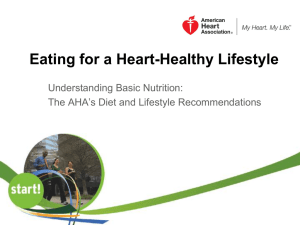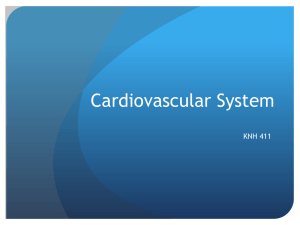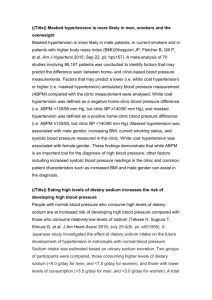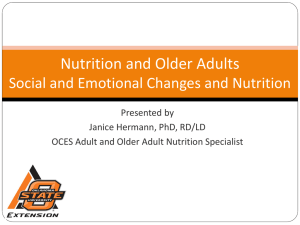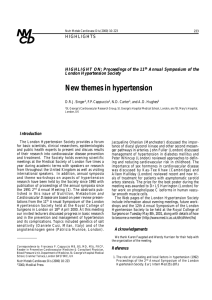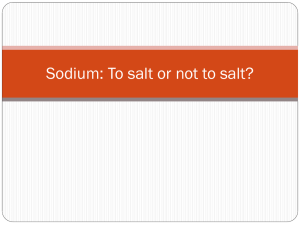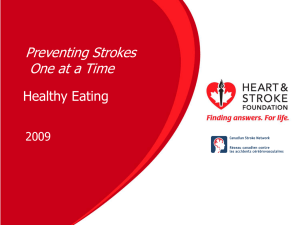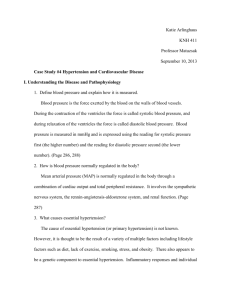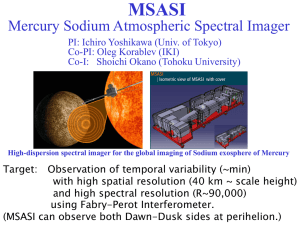File - Medical Nutrition Therapy Portfolio
advertisement
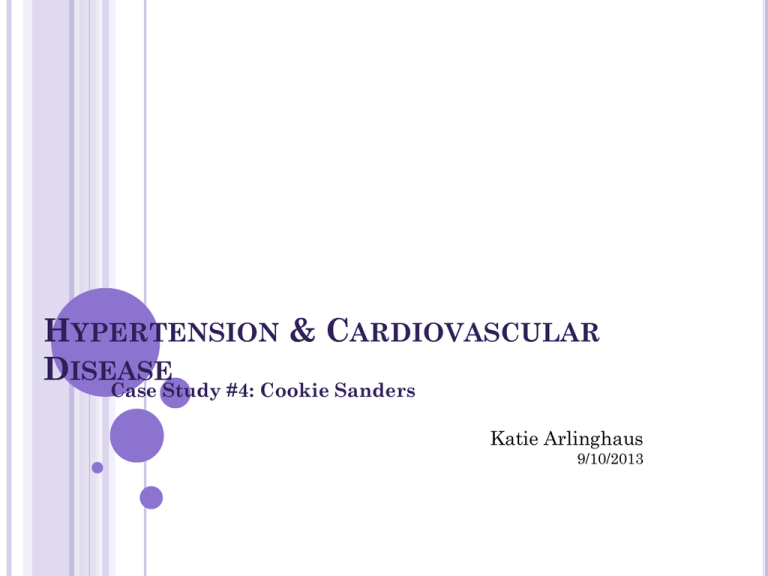
HYPERTENSION & CARDIOVASCULAR DISEASE Case Study #4: Cookie Sanders Katie Arlinghaus 9/10/2013 COOKIE SANDERS 54-year old African American female Diagnosed with Stage 2 HTN 1 year ago Quit smoking upon diagnosis a year ago Lost 10 lbs within the year from walking 30 minutes 4-5 times a week Abandoned efforts to comply with suggested low sodium guidelines because she found foods to be bland and tasteless Mother died from MI as a result of uncontrolled HTN VITALS AND LAB RESULTS Blood Pressure: 160/100mmHg Height: 5’ 6” Weight: 160 lbs BMI: 25.8 Laboratory Results Cholesterol 270mg/dL HDL-C: 30mg/dL LDL: 210mg/dL Apo A: 75mg/dL Apo B: 140mg/dL Triglycerides: 150mg/dL HYPERTENSION ETIOLOGY Chronic elevation of blood pressure Higher than 120/80mmHg To have high blood pressure systolic pressure and/or diastolic pressure can be too high At 160/100mmHg, Mrs. Sanders has Stage 2 Hypertension Category Systolic BP (mm Hg) Diastolic BP (mm Hg) Normal <120 an d <80 Prehypertension 120-139 or 80-89 Hypertension: Stage 1 140-159 or 90-99 Hypertension: Stage 2 ≥ 160 or ≥ 100 TYPES OF HYPERTENSION Primary (or Essential) HTN has no known cause but is thought to be the result of a variety of factors including: Diet (high sodium, alcohol intake; low potassium) Smoking Lack of Exercise Stress Obesity Genetic component contributing to the management of sodium balance Primary HTN accounts for 90% HTN diagnosis Secondary HTN is the result of another primary problem like CVD, Renal disease, etc TABLE 13.2: EFFECTS OF DIETARY FACTORS & DIETARY PATTERNS ON BP: A SUMMARY OF THE EVIDENCE Evidence Key: +/- indicates limited or equivocal evidence + indicates suggestive evidence from observational and clinical trials ++ indicates persuasive evidence from clinical trials HOW IS HYPERTENSION DIAGNOSED? Nicknamed “the silent killer” because there are typically no symptoms of HTP If untreated, can cause congestive heart failure, kidney failure, myocardial infarction, stroke, and aneurysms Common Nutrition diagnoses include: Excessive energy intake Inappropriate intake of fats Excessive sodium intake Inadequate calcium, fiber, potassium, or magnesium intake Overweight/obesity Food and nutrition-related knowledge deficit Physical inactivity TREATMENT Goals Reduce risk of cardiovascular disease Reduce blood pressure to <140/80 mmHg Methods Weight reduction Physical activity Pharmacological interventions Nutrition therapy PHARMACOLOGICAL INTERVENTION Medication Photo: Wall Street Journal Mechanism of Action Nutritional Side Effects Diuretics Decreases blood volume by increasing urinary output and inhibits renal Na and H20 reabsorption Potassium supplements may be necessary, avoid natural licorice Betablockers Blocks B-receptors in the heart to decrease heart rate and cardiac output Calcium may interfere with absorption Calciumchannel blockers Affect the movement of calcium and cause blood vessels to relax and reduce vasoconstriction Avoid natural licorice, limit caffeine, and avoid or limit alcohol ACE inhibitors Vasodilators that reduce blood pressure by decreasing peripheral vascular resistance by interfering with the production of angiotensin II from angiotensin I and inhibiting degradation of bradykinin Avoid natural licorice, and avoid salt substitutes Alphaadrenergic blockers Blocks the vascular muscle response to sympathetic stimulation and reduces stroke volume. Avoid natural licorice NUTRITION THERAPY DASH Diet Dietary Approaches to Stop Hypertension The plan emphasizes whole-grain products, fish, poultry, nuts, low-fat dairy, vegetables, and fruits. It limits red meat, sweets, and sugary beverages Sodium reduction No more than 2300mg/day, <1500mg/day is best Avoid processed foods Increase potassium, calcium, and magnesium MRS. SANDERS’S HTN RISK FACTORS African American Family history Smoked Overweight High cholesterol Diet High sodium intake High saturated fat intake Excessive energy intake NUTRITION THERAPY FOR MRS. SANDERS Excessive sodium intake related to frequent consumption of high sodium foods as evidenced by patient’s 24-hour diet recall and high blood pressure of 160/100mmHg. High cholesterol related to inappropriate intake of fats as evidenced by patient’s 24-hour diet recall and lipid profile lab results of total cholesterol of 270mg/dL with high LDL levels of 210mg/dL, and low HDL levels of 30 mg/dL. NUTRITION THERAPY GOALS Lower blood pressure to <120/80mmHg by educating Mrs. Sanders on ways to add flavor to foods without adding salt and implementing the DASH diet with less than 2300mg salt a day. Reduce total cholesterol to <200mg/dL, lower LDL level to <130 mg/dL, and raise HDL level to >55 mg/dL by educating Mrs. Sanders on the importance of and how to implement the DASH diet plan into her daily life. HOW MUCH SODIUM IS IN THAT? ORDER THE FOLLOWING FROM HIGHEST TO LOWEST SODIUM CONTENT: 5-ounce frozen turkey & gravy dinner 1 cup raisin bran cereal 1 cup vegetable juice cocktail 1 tablespoon Teriyaki sauce 1 tablespoon soy sauce 1 ounce potato chips 1 ounce cheese puffs 1 ounce pretzels 1 (4g) dill pickle spear …I’LL GIVE YOU A HINT: THERE’S A LOT! 1. 2. 3. 4. 5. 6. 7. 8. 9. 1 tablespoon soy sauce 1,024mg 5-ounce frozen turkey & gravy dinner 787mg 1 tablespoon Teriyaki sauce 690mg 1 cup vegetable juice cocktail 479mg 1 ounce pretzels 385mg 1 (4g) dill pickle spear 306mg 1 cup raisin bran cereal 250mg 1 ounce cheese puffs 240mg 1 ounce potato chips 136mg PROGNOSIS There is no “cure” for hypertension but can be controlled through medical nutrition therapy and/or medication. Sodium modifications may reduce incidence of hypertension as much as 17% Weight loss greater than 5kg reduced both diastolic and systolic BP ~20lb weight loss results in lowered systolic BP <10% weight loss has sustained effect on BP REFERENCES Academy of Nutrition and Dietetics. (2005). Evidence Analysis Library: What evidence suggests a relationship between sodium intake and blood pressure in healthy and hypertensive adults? Retrieved from http://andevidencelibrary.com/conclusion.cfm?conclusion_statement_id=250636 &highlight=sodium&home=1 Group Health Cooperative. (2011). Statins & ACE Inhibitors. Retrieved from https://provider.ghc.org/open/caringForOurMembers/patientHealthEducation/c onditionsDiseases/statins.pdf. Nelms M, Sucher K, Lacey, K., Habash, D., Roth S. Nutrition Therapy and Pathophysiology. 2nd ed.Belmonte, CA: Thomson Brooks/Cole, 2010. Net Industries Science Encyclopedia. (2013). Hypertension-Prognosis. Retrieved from http://science.jrank.org/pages/3488/HypertensionPrognosis.html. Smith MEB, Lee NJ, Haney E, et al. Drug Class Review: HMG-CoA Reductase Inhibitors (Statins) and Fixed-dose Combination Products Containing a Statin: Final Report Update 5 [Internet]. Portland (OR): Oregon Health & Science University; 2009 Nov. Retrieved from: http://www.ncbi.nlm.nih.gov/books/NBK47273 Zelman K. (2012). Salt Shockers. Retrieved from http://www.webmd.com/diet/ss/slideshow-salt-shockers.
